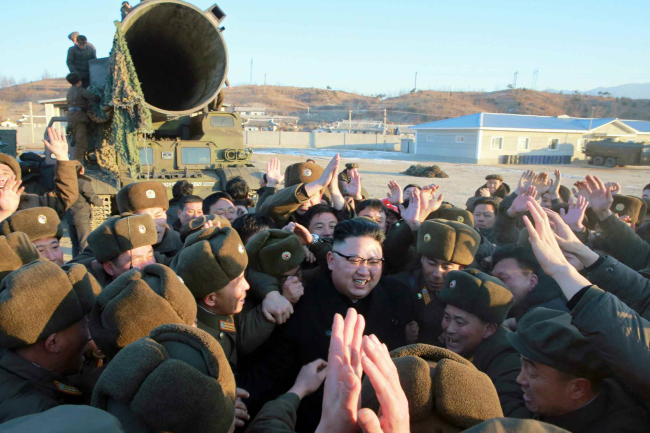With its test of a new intermediate-range ballistic missile, North Korea appears to be making progress in its efforts to refine its ballistic missile technologies and secure various delivery methods for nuclear weapons, Seoul officials and analysts said Monday.
The North’s state-run Korean Central News Agency said that through Sunday’s launch, the country succeeded in test-firing the Pukguksong-2 -- a surface-to-surface medium- and long-range ballistic missile -- and proving rocket technology that can deliver the missile further without being detected and intercepted.
 |
This photo released by North Korea’s state-run Korean Central News Agency shows Kim Jong-un celebrating with soldiers the successful launch of the intermediate-range ballistic missile Pukguksong-2 on Sunday. (Yonhap) |
Seoul’s Joint Chiefs of Staff acknowledged the Pukguksong-2 was a new type of intermediate ballistic missile based on the technology used in submarine-launched ballistic missiles, reversing their previous assessment that it was a modified version of the intermediate Musudan-class missile.
“I think they created something in between a Musudan missile and an intercontinental ballistic missile,” said Kim Dong-yup, a professor at Kyungnam University’s Far East Institute. “It is more like a test for a first-stage propellant of ICBM. If combined with the second propellant, it can open up the path for ICBM.”
Through the missile test, North Korea claimed to succeed in separating the missile’s propellants from its warhead, which can be tipped with nuclear weapons, and using solid fuel propellant for the missile’s powered engine.
The JCS also concluded that the propellant seemed indeed to have been separated, and said the new engine system may be applicable to the KN-08, an ICBM that is expected to be capable of reaching the continental US but has not yet been tested.
Regarding the North’s claim that it uses an “cold-eject” launch system when launching the missile on the ground, experts noted it was a technological breakthrough. The system helps the missile lift off the ground using pressure and then ignite mid-flight, as opposed to igniting it on the ground, which is said to be less stable. The technology is believed to have been employed during its SLBM tests last year.
“It is quite rare to launch an intermediate ballistic missile on the ground using the cold-launching system, but they definitely demonstrated such capability on the ground. It is very sophisticated technology,” said Lee Chun-geun, a researcher at the Science and Technology Policy Institute,
The military said it confirmed for the first time that Pyongyang used a missile launching truck with caterpillar, an equipment that can deliver the IRBM to hostile surface terrain. Previously, the regime had carried their missile using wheels attached to the vehicle.
Combined with the truck that can improve the ability to conceal the missile, North Korea asserted that the missile’s nuclear warhead has “the feature of evading intercepting” that might neutralize South Korea’s efforts to build an advanced missile defense system, such as the Terminal High Altitude Area Defense system.
“I’m afraid that they are working on developing a missile that can neutralize our missile defense system such as the THAAD,” said Yang Uk, a senior research fellow at Korea Defense and Security Forum. “If the missile were to be fired at 45 degrees, its range could be up to 1,000 kilometers, which includes the whole country.”
By Yeo Jun-suk (
jasonyeo@heraldcorp.com)








